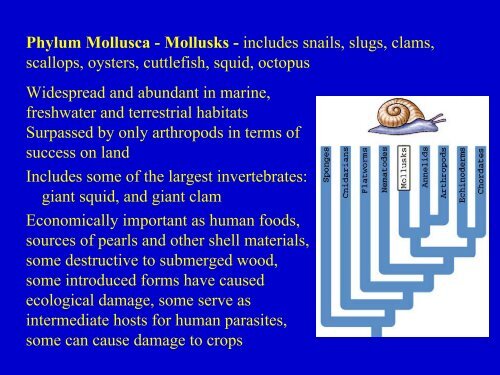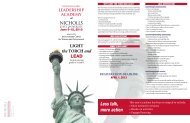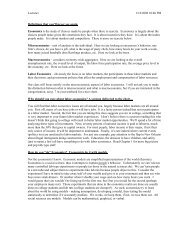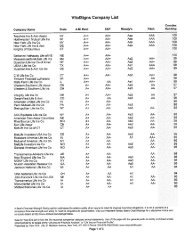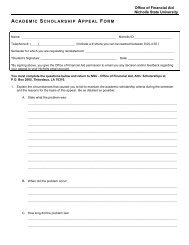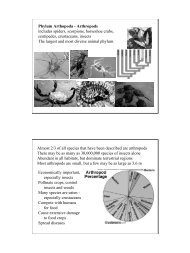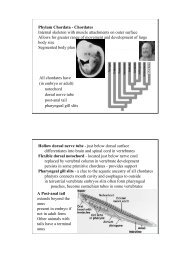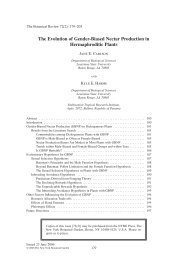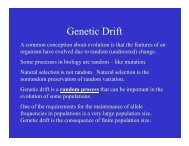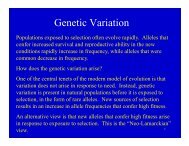Phylum Mollusca - Mollusks - includes snails, slugs, clams, scallops ...
Phylum Mollusca - Mollusks - includes snails, slugs, clams, scallops ...
Phylum Mollusca - Mollusks - includes snails, slugs, clams, scallops ...
You also want an ePaper? Increase the reach of your titles
YUMPU automatically turns print PDFs into web optimized ePapers that Google loves.
Mollusk body plan: head-foot, visceral mass, mantlehead-foot - continuous muscular mass - with sensory and feedingstructures associated with head, and foot for locomotionvisceral mass - contains organs of digestion, reproduction,circulation, excretionmantle - coversvisceral mass andsecretes shellmantle cavitycontains gills,and ducts forreproduction andexcretion
Basic body plan has been modified for different purposes in thedifferent classes - Chitons closest to basic plan. Gastropods havetwisted visceral mass. Bivalves have lost head, and gills areused for feeding. Cephalopods have modified foot into tentacles,and mantle is used for jet propulsion.
All mollusks except Bivalves possess a rasping, tongue-like,radula - composed of dozens of rows of chitinous teethSome gastropods scrape algae with radula, others use radula totear apart prey or drill holes in shells of their prey
Circulatory system is open in mostHeart collects blood from gills and pumps to sinuses that extendthrough bodyCephalopods have a closed system of vessels and auxiliary heartsCoelom is primarily represented by small area around the heartNephridium forexcretion- collectsfluid from coelomand empties intomantle cavity -valuable solutesresorbed by wallsof tubule
ReproductionMost have separate sexes, some hermaphroditic, some change sex,most have internal fertilization, copulation between males andfemales (except in bivalves)<strong>Mollusks</strong> dispersed through larval formsMany have free-swimming trochophore larvaeA second free-swimming veliger stage may precede adult form
Class Polyplacophora - ChitonsHave oval bodies, and shellwith eight overlappingplatesVery similar to basic bodyformChitons creep along onbroad, flat footFoot surrounded by mantlecavity with series of gillsMost are shallow waterherbivores that graze onalgae
Class Gastropoda - Snails and SlugsPrimarily marine, with many freshwaterand terrestrial formsMost have shell, shell lost in <strong>slugs</strong>Head possess paired tentacles that mayhave terminal eyesVisceral mass asymmetricalbecause of torsion (twisting)during development120° twist results in loss of rightgill and positioning of anus to theright of the headCoiling of shell due to one side ofsnail growing faster than other -not due to torsion
Varied feeding habitsTerrestrial herbivores can be serious garden pestsOyster drills bore into other mollusk shells, kill and eat bodyCone shells are predators with harpoon-like radulaSome sea <strong>slugs</strong> (nudibranchs) eat cnidarian polyps andincorporate stinging cellsTerrestrial forms evolved a rudimentary lung under mantleAir has much more oxygen than water - a lung is moreefficient than a gill in airFreshwater forms evolved from terrestrial forms and lack gills
Class Bivalvia - BivalvesIncludes <strong>clams</strong>, <strong>scallops</strong>,mussels, oystersHave a single shell with two valves - hinged at top - held together bya ligament - closed by adductor musclesMantle covers entire body - secretes shells and ligament, often formsincurrent and excurrent siphonsTwo pairs of gills are located under folds of the mantle - used forfeeding and gas exchangeFoot is wedge-shaped - can be extended for crawling, burrowing,anchoring
Most forms are sedentary filter feedersFood particles collected on gills and entangled in mucus -cilia on gills convey food to mouthPlanktonic larval stage (trochophore) allows dispersalScallops are unique, very mobile formsswim by open and closing shellAbundant in marine and freshwater habitatsFreshwater mussels distributed worldwideMore than 500 species live in lakes and rivers of North AmericaLarvae brooded in special pouch in gill chamberLarvae are parasites on fish - larvae are called glochidia
Class Cephalopoda - Octopus, Squid and NautilusActive predators - most lack external shell (except Nautilus)Foot has evolved into a series of tentacles8 in octopus, 10 in squid, up to 90 in NautilusTentacles snare prey, beaklike jaws bite, radula pulls prey intomouth
Have highly developed nervous systemsRapid responses result from giant nerve fibers attached tomantleEyes are elaborate with retina similar to that in vertebratesExhibit complex behaviors and high level of intelligenceTake water into mantle and expel it through siphon for propulsionChange direction of movement with siphonMay eject dark fluid to confuse predatorsMost have closedcirculatory system thatprovides more efficientcirculationSexes are separateSpecialized tentacle in male transmits spermatophore to femaleEggs fertilized as they leave the oviductextensive parental care in some
<strong>Phylum</strong> Annelida - Annelids - Segmented Worms<strong>includes</strong> sandworms, fanworms, bristleworms, earthworms,leechesmost are marine, but they are also commonon land and in freshwater
Segmentation is the key innovation for this groupSegments - modular structure - allows evolutionary and functionalflexibility - slight modifications result in new functionsEach segment is arelatively complete unit -each partitioned from theothers by septa,Each segment containsits own excretory organs,and nerve concentrationsthat control the actionsof the segment called“ganglia”Each segment can expand or contract independently - with circularand longitudinal muscles working around water-filled coelom
Segments are specialized for specific functionsAnterior segments for feeding and sensory input - one segmenthas a brain that can control ganglia of other segments -connected by two ventral nerve cordsOther segments contain hearts that distribute blood through aclosed circulatory system to all segmentsExcretion bysegmentalnephridia - emptycoelomic fluid tooutside and recoversolutesGas exchange occurs at body surface
Three classes of AnnelidsClass Polychaeta - marine worms - fan worms, feather worms,tube worms, bristleworms, sandworms, etc.Class Oligochaeta - earthworms - both terrestrial and freshwaterClass Hirudinea - leeches - mostly freshwater, some terrestrial andmarine
Class Polychaeta - Polychaetes -“many bristles” - marine wormsHave well developed heads withspecialized sensory and feeding structuresHave paddle-like parapodia - forlocomotion and aid in gasexchange - with many bristlescalled “setae”Separate sexes with externalfertilization -Have trochophore larva - likesome mollusksAn important link in marine foodchains - many live in associationwith sponges, mollusks,echinoderms, crustaceans
Class Oligochaeta - “few bristles” - EarthwormsUsually burrow in soil - lack eyes - but have sensory systems thatdetect light, touch, and moistureHave fewer setae than polychaetes - important in burrowing foranchoring segments in burrowEat soil and organic debris - muscular gizzard grinds food -castings deposited at surface - increase soil aeration and porosityHermaphroditic - individuals meet - clitellum of each formsmucus ball around partners - exchange sperm - eggs depositedinto mucus ball - dries into “cocoon” - no larvae - fertilized eggshatch as small immature worms
Class Hirudinea - LeechesMost are freshwater, some terrestrial and marine - mostare predators or scavengers, some are parasitesLoss of septa between segments, most have no setaeHave suckers at both ends for prey capture, attachment,and locomotionHermaphroditic with mating similar to earthwormsleeches appear to have evolved from earthwormsExample: Hirudo medicinalisthe medicinal leech - aparasite - mouth haschitinous teeth, attaches,bites, secretes anticoagulant“hirudin” -leeches are used to removeblood from beneath skin aftersurgery and from some woundsHirudin is used to prevent clotformation during surgery


